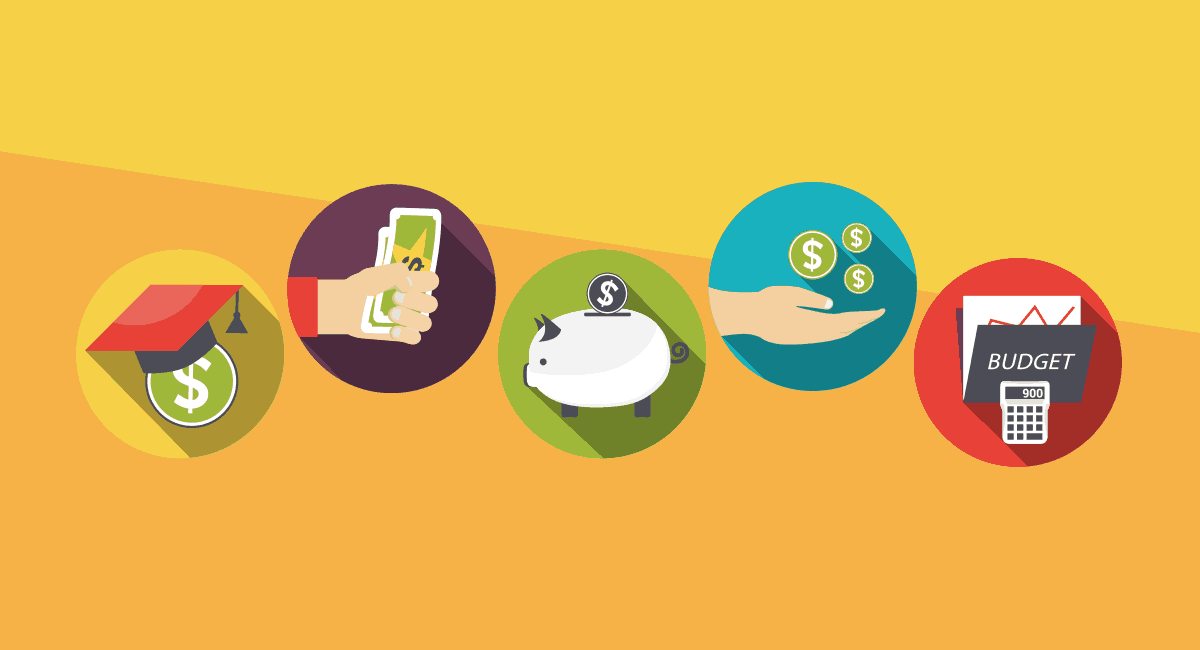March 26, 2018

Student loans are among the easiest forms of debt to let pile up and can plague a borrower for a lifetime, potentially undercutting long-term financial goals if they aren’t handled correctly. Even though the balance on your loans can feel overwhelming, however, there are some great options for getting out from under the shroud of student loans much sooner than you thought possible. Here are five of the best ways to take control of your debt and pay off your student loans long before the end of your repayment term.
The golden rule: extra payments.
There’s a good possibility that the two biggest investments in your life will be your education and your home, which is why some of the same strategies can be applied to both student loans and mortgages. One of the absolute best ways to get ahead is to double-up on payments whenever possible, as this type of financial discipline can allow you to reap enormous rewards. Instead of carrying the standard principal versus interest ratio of your usual payments, extra payments should go directly to your principal and allow you to significantly shorten the length it takes you to close out your loan.
To really capitalize, it’s recommended that you supply an extra payment every three or four months, which is more than enough to give you substantial leverage over your debt. But even if this is not feasible in your case, one or two extra payments per year can still have a substantial impact that will significantly pay off down the road. If you work in a profession that has annual or semi-annual bonuses, you also have built-in opportunities to slice into your student debt that many wisely take advantage of. Even relatively small lump-sum payments from a bonus can cut your loan payment schedule by months.
To ensure your extra payments do what they’re supposed to do, however, experts suggest you write to your lender in advance of your first additional payment, creating a written record of your plans and allowing both lender and borrower to get on the same page. Once you’re confident that your extra payments will be applied strictly to the principal, every payment you make will have an important impact on your financial future.
Apply for loan forgiveness or repayment programs.
Just like the many grants and student aid packages available before you start your higher education, there are plenty of similar ways for graduates to decrease – or eliminate – student debt. Unfortunately, these programs are often marred by obscurity and many with student loans simply have no idea that all they have to do is submit an application. These programs are mainly designed to provide relief to fields that come with substantial debt (e.g. physicians, lawyers) as well as those in the public sector that don’t typically earn a high salary (e.g. teachers), but it’s worth looking into regardless of your profession.
On the federal level, those with Perkins or Stafford loans, for example, can potentially have their loans completely forgiven depending on personal circumstances. Many individual states also offer grants and aid programs available to those with both government and private loans. Even if you’re skeptical that you work in a field that might apply, keeping an eye on the evolving list of loan forgiveness and repayment programs can be a crucial first step towards getting a handle on your student loans.
If you’re just beginning your higher education, or adding to your degree, it’s also critically important that you fill out a FAFSA form (Free Application for Federal Student Aid), as it will get you started towards finding any available grants, loans, and student-work programs. Many make the mistake of thinking they would not meet the requirements for FAFSA or that they don’t actually need financial aid, which can turn out to be a costly mistake. Considering that the final total of one’s education usually tends to be more than the original estimation, getting as much aid upfront is an important way limit your loans and help you eradicate your student debt as quickly as possible after graduation.
Don’t be afraid to refinance.
Refinancing can certainly seem like a hassle if your student loans are going smoothly, as many simply don’t want to put the time and effort it takes into refinancing. Unfortunately, this is also what your lender is banking on while consolidated student loan rates in the 3-4% range are available – particularly for those with good to excellent credit. With current interest rates still relatively low, refinancing to a lower rate can save you a significant amount of money and in some cases, you might be able to slice the amount of paid interest in half.
For example, a $100,000 student loan with a standard 7% interest rate will come in just below $40,000 in total interest paid over the course of a 10-year loan, which averages out to about $1,160 per month. By refinancing to a 4% interest rate, which might not even be the lowest available if you have terrific credit, you can save about $150 per month in interest and nearly $18,000 over the course of a decade. The interest savings might be enough to pay most – if not all – of a monthly car payment or give you a substantial advantage when it comes to saving for a mortgage or retirement.
Considering many are paying above 7% interest for student loans, the potential savings are actually quite a bit higher. Although you do have to be especially cognizant of the loan details if you switch to a private lender, the advantages of refinancing can be a game-changer. To get a general idea of what you can save on a student loan, comparing your current loan with refinancing options on a student loan calculator can give you the encouragement that it’s worth the effort.
Take advantage of companies offering student loan repayment programs.
One of the ways that some of today’s companies are trying to attract new talent is by offering student loan repayment programs, which are becoming more and more prevalent thanks to a large number of employees carrying student debt. In recent years, companies like Fidelity and PricewaterhouseCoopers have joined the trend and offer monthly contributions to an employee’s student loan balance, with programs typically being worth roughly $1-$2k per year.
In the case of Fidelity, employees can expect up to $10,000 of their loans to be repaid and many other companies now offer loan management tools to assist employees. When looking for new employment, a student loan repayment program can be a significant advantage and it also might be worth checking to see if your current employer has any similar programs designed to help employees with student loans.
Go beyond the minimum payments (but be careful).
Just because you’re not able to afford regular extra payments doesn’t mean that your hands are tied to your repayment schedule. An easy and effective way to improve your student debt outlook is to simply tack on a little more to the minimum payment each month, which can help you form a great long-term habit that will get you out from under your loans faster. As little as $25 or $50 extra a month can allow you to pay off your loan much quicker and help you save thousands of dollars that would otherwise go to interest.
But going above the minimum payments also comes with a potentially infuriating drawback depending on what the lender does with the extra money. Many have reported to the Consumer Financial Protection Bureau that lenders are secretly lowering future minimum payment levels and adding extra payments to the end of the repayment cycle. This means that the money you think is going directly to the principal is actually going to future payments, which mostly defeats the purpose of paying more than the minimum.
That’s why, if you plan on paying more than the minimum or making additional payments, contacting your lender in advance is the best method to ensure your money is going towards the principal. Although you can find plenty of great lenders that work hand-in-hand with a borrowers’ goals, it’s never a bad idea to keep an eye on the details of your loans and be ready to call your lender if you see anything unusual.
Other options to consider.
Repayment funds.
An extremely straightforward method that can be a boon to anyone with student loans is to set up a basic repayment fund that will only be used to pay down the principal. If you want to go this route, it’s a good idea to create a fund completely separate from any of your current accounts and to initiate regular contributions. You can use the fund to do occasional lump-sum payments, put you in a position to pay off the total balance of your loan, or use as insurance in case your finances get tight and you’re tempted to skip a payment.
Bi-weekly loan payments.
Changing your repayment plan to every other week instead of once a month can be a subtle but helpful maneuver that can organically lead you to a full extra month of payments during the course of the year. Although you once again might have to contact your lender to make sure that the additional payments go towards the principal, many who get paid every other week go with this option to provide a leg up on repayment.
Please note that the information provided on this website is provided on a general basis and may not apply to your own specific individual needs, goals, financial position, experience, etc. LendKey does not guarantee that the information provided on any third-party website that LendKey offers a hyperlink to is up-to-date and accurate at the time you access it, and LendKey does not guarantee that information provided on such external websites (and this website) is best-suited for your particular circumstances. Therefore, you may want to consult with an expert (financial adviser, school financial aid office, etc.) before making financial decisions that may be discussed on this website.



